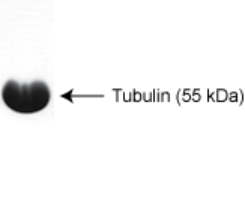當(dāng)前位置: 首頁 - 產(chǎn)品專區(qū) - 熱銷產(chǎn)品

Tubulin (porcine brain, >99% pure)
| 貨號 | T238P-A | 售價(jià)(元) | 2548 |
| 規(guī)格 | 1 x 1 mg | CAS號 |
- 產(chǎn)品簡介
- 相關(guān)產(chǎn)品
Product Uses Include:
IC50 & EC50 determinations for anti-tubulin ligands.
Microtubule binding studies
Tubulin monomer binding studies
HDAC6 studies
Microtubule activated kinesin ATPase assays
Material:
Tubulin protein has been purified from porcine brain by an adaptation of the method of Shelanski et al. (1), Further purification to >99% purity was achieved by cation exchange chromatography. Tubulin is supplied at 10 mg/ml as a frozen liquid in G-PEM (General tubulin buffer (Cat. # BST01) with 1 mM GTP (Cat. # BST06)).
This product is also available in a lyophilized, fully active format (Cat. # T240). The lyophilized format tubulin has many advantages over the frozen format. T240 costs less and since it allows for ambient temperature shipping, shipping is also significantly less costly. In addition, the lyophilized format allows for simpler (+4°C desiccated vs -70°C) and longer storage.
T238P is simular to T237 when 10% glycerol is added. >99% pure tubulin is also available in a convenient lyophilized pre-formed microtubule format (Cat. # MT001) for use in e.g. kinesin ATPase assays and microtubule binding studies.
Purity:
Purity is determined by scanning densitometry of proteins on SDS-PAGE gels. Samples are >99% pure.

Figure 1: 100 μg of T238P was run on a 10% SDS-PAGE gel and stained with Coomassie Blue.
Biological Activity:
The biological activity of T238P is assessed by a tubulin polymerization assay. The ability of tubulin to polymerize into microtubules is followed by observing an increase in optical density at 340nm (OD340 nm) of a tubulin solution. Under the experimental conditions defined below a 5 mg/ml tubulin solution in General tubulin buffer (Cat. # BST01) buffer plus 5% glycerol (Cat. # BST05) and 1 mM GTP (Cat. # BST06) should achieve an OD340 nm absorption reading between 0.75 - 1.10 in 30 min at 37°C. The assay volume is 180 ul and assumes a spectrophotometer pathlength of 0.8 cm. See Fig 2 on the TL238 datasheet page for an example of tubulin polymerization results.
It should be noted that tubulin minus glycerol WILL NOT polymerize in G-PEM buffer until very high tubulin concentrations (>10 mg/ml). Even at these concentrations polymerization is comparatively slow. Efficient polymerization at lower concentration of tubulin minus glycerol can be achieved by addition of a polymerization stimulating compound, e.g., paclitaxel or DMSO. See Figure 2 on the T237 product page for polymerization in the presence of glycerol and paclitaxel.
References:
Shelanski, M. L., et al. (1973). Proc. Natl. Acad. Sci. USA. 70, 765-768


